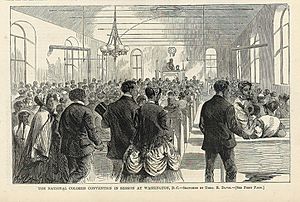Colored Conventions Movement facts for kids
The Colored Conventions Movement was a series of important meetings held by African Americans, both before and after the American Civil War. These gatherings happened in many states across the U.S. and even in Canada. More than five thousand people took part in these conventions.
People who attended included religious leaders, business owners, politicians, writers, and those who worked to end slavery. These conventions gave Black leaders a way to work together. They could discuss goals for African Americans and fight for their rights.
The records from these meetings show that African Americans wanted more than just an end to slavery. They also organized to talk about fair jobs, health care, and the right to vote. They discussed equal education and the right to a fair trial. This movement started even before formal groups against slavery were formed in the United States.
After the Civil War, even more Colored Conventions took place. These early conventions helped pave the way for bigger African American organizations. Groups like the Colored National Labor Union and the National Association for the Advancement of Colored People (NAACP) grew from this movement.
History of the Conventions
In the early 1800s, many Americans started holding conventions to discuss political and social issues. Historians note that African Americans used these meetings to express themselves more freely. Newspapers like Freedom's Journal also helped spread the idea of holding conventions.
The first known convention happened in September 1830. It was held at Mother Bethel A.M.E. Church in Philadelphia. At first, the people at this meeting talked about moving to Canada. They hoped to find safety from harsh laws against formerly enslaved people and unfair treatment. Richard Allen, who founded the first independent Black church in the U.S., was elected president of this first convention. Soon, the idea of moving changed. The delegates decided to focus on problems they faced at home, like getting good education and fair jobs.
Philadelphia was a main center for the Colored Conventions for several years. Then, other cities like New York City, Albany, and Pittsburgh also began hosting meetings. By the 1850s, these conventions were very popular. Many national, state, and local meetings were held every year. Most of these early conventions were in northern states. However, meetings also took place in Kansas, Louisiana, and California.
The conventions brought together many famous African American leaders. These included Frederick Douglass, Mary Ann Shadd, and William Still.
After the Civil War, Colored Conventions started happening in the Southern states too. One writer noted that the meetings in the South were just as good as those held by white groups. They focused on important ideas like humanity and common sense. More conventions took place in the South in the late 1860s than in the entire period before the war.
The post-war conventions reached a high point with the 1869 National Convention of Colored Men in Washington, D.C. The people at this meeting wrote a letter to General Ulysses S. Grant. They congratulated him on becoming President of the United States. President Grant replied, saying he hoped African Americans would receive all the protection the laws offered. He promised to work to ensure they got that protection.
During the time of Reconstruction, these national, state, and local conventions changed. They became other types of state and national groups. For example, delegates at the National Convention of Colored Men in Syracuse, New York, created the National Equal Rights Leagues. They tried to form chapters of this league across the U.S. When African Americans were not allowed to join the National Labor Union, leaders formed the Colored National Labor Union (CNLU) in December 1869. Many people who had been part of the Colored Conventions, like Isaac Myers and Frederick Douglass, helped start the CNLU.
Colored Conventions continued into the late 1880s and 1890s. Meetings were held in places like Indianapolis in 1887. State conventions also took place in New Jersey, Alabama, Louisiana, and Texas. The movement slowed down by the end of the century.
Legacy of the Movement
The Colored Conventions Movement had a lasting impact. It helped create many important organizations that continued the fight for civil rights.
For example, T. Thomas Fortune formed the National Afro-American League in 1890. This group held national and state meetings throughout the 1890s. From 1896 to 1914, W. E. B. Du Bois held an important yearly conference at Atlanta University. In 1898, bishop Alexander Walters founded the National Afro-American Council. This group met every year until 1907. Fortune and Booker T. Washington were key figures in this council.
In 1905, Du Bois and William Monroe Trotter met near Niagara Falls, Canada. They founded the Niagara Movement. Du Bois's continued work and the connections he made at these meetings led to something even bigger. In 1909, he, along with Moorfield Storey and Mary White Ovington, founded the National Association for the Advancement of Colored People (NAACP). The NAACP is still a very important organization today. It continues to work for the rights and progress of Black people.
Images for kids



